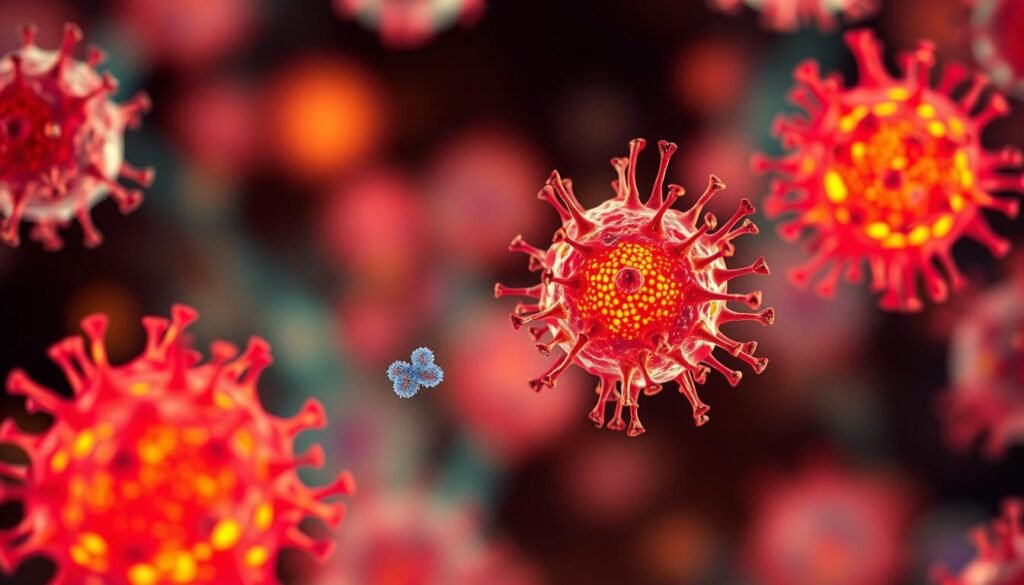Every year, about 234,000 people in the United States learn they have lung cancer. This high number shows the great need for new and better treatments. Yervoy (ipilimumab) and Opdivo (nivolumab) are groundbreaking options. They are made by Bristol Myers Squibb. They use immunotherapy to fight lung cancer.
This guide will help you understand how Yervoy and Opdivo work. You’ll learn about the way these drugs help your immune system fight cancer. We’ll also cover when these treatments are recommended and the side effects they may have. It’s important for patients to know about these things. This knowledge can help in the fight against lung cancer.
Key Takeaways
- Yervoy and Opdivo are key immunotherapy lung cancer treatments developed by Bristol Myers Squibb.
- These drugs offer new hope for patients diagnosed with advanced stage non-small cell lung cancer.
- Understanding the mechanisms and side effects of Yervoy and Opdivo is essential for effective treatment.
- Immunotherapy blends cutting-edge science with individual patient care for improved outcomes.
- Monitoring for side effects is crucial when undergoing treatment with Yervoy and Opdivo.
Introduction to Immunotherapy in Lung Cancer
Immunotherapy is changing cancer care in a big way. It uses our immune system to fight off cancer. This is especially important for lung cancer, which affects about 2.1 million people each year. Most of these cases are non-small cell lung cancer (NSCLC), making up 85-90% of all lung cancers. This highlights the urgent need for new treatments like immunotherapy.
Looking back, lung cancer treatments have greatly evolved. They moved from mainly using chemotherapy to more precise methods. Chemotherapy’s tough side effects and limited success led to seeking better options. In 2015, the U.S. FDA’s approval of immunotherapy was a game-changer, showing hopeful results that keep getting better.
Immunotherapy targets the cancer in a smart way. It uses medicines like Opdivo and Yervoy to help the immune system find and kill cancer cells. Studies show that people treated with immunotherapy live longer than those with standard treatments. This is a big step forward in lung cancer care.
New drugs like Atezolizumab and Pembrolizumab are showing promise in treating advanced lung cancer. They could lead to better survival rates for patients. In fact, more than 15% of those treated with immunotherapy are living longer and enjoying a better quality of life.
The future looks bright with immunotherapy. It offers new hope to those with lung cancer. With ongoing research, we’re moving towards personalized therapies that could greatly improve survival and the overall experience for patients.
Understanding Yervoy and Opdivo
Yervoy (ipilimumab) and Opdivo (nivolumab) are key players in lung cancer treatment. They work together to strengthen the immune system. Yervoy helps by activating T-cells to fight cancer. On the other hand, Opdivo prevents cancer cells from blocking immune attacks.
These medications are given through vein infusions. The doses and timings are customized for each person. A common treatment involves Opdivo 3 mg/kg and Yervoy 1 mg/kg every 3 weeks. This approach has shown to improve outcomes, especially for those not benefiting from single therapies.
https://www.youtube.com/watch?v=f2kp_XrNLjU&pp=ygUJI2hjY2thYmF0
In studies, Opdivo and Yervoy showed positive results in treating various cancers, like non-small cell lung cancer (NSCLC). Research shows better survival rates with their combined use, especially in advanced diseases.
It’s important for doctors and patients to understand both Yervoy and Opdivo. They mark a major advancement in fighting cancer by boosting the immune system.
Yervoy and Opdivo for Lung Cancer: How They Work Together
The nivolumab ipilimumab combination is a new way to fight advanced lung cancer. It uses both opdivo and yervoy to make the body’s immune system stronger against cancer cells. This treatment is especially good for patients with high PD-L1 levels and no EGFR or ALK mutations in their tumors.
This combination therapy boosts the immune system to better identify and attack cancer cells. Opdivo, a PD-1 inhibitor, stops tumors from hiding from the immune system. Meanwhile, yervoy, a CTLA-4 inhibitor, makes the immune response even stronger, leading to a more powerful attack on the cancer.
Clinical trials have shown that people getting both nivolumab and ipilimumab fare better than those getting just one. One study found they had less disease progression. This suggests using both opdivo and yervoy can help patients live longer.
Real-life cases back up these results. A good number of patients do well on the combination therapy. This proves it’s an effective way to treat advanced lung cancer by boosting the immune fight against tumors.
Indications for Use in Lung Cancer Treatment
Lung cancer is the top cause of cancer deaths worldwide. Immunotherapy, such as Yervoy (ipilimumab) and Opdivo (nivolumab), targets lung cancer stages. This includes recurrent non-small cell lung cancer and cases after chemotherapy. These methods offer new hope to qualified patients.
Indications for use lung cancer treatment are crucial to understand. The FDA approves these therapies for certain patients. This decision is based on clinical trials and biomarker exams. With Opdivo alone, around 3.1% of patients get immune-mediated pneumonitis. Yet, the rate is higher with Yervoy combination therapy.
For example, mixing Opdivo at 1 mg/kg with Yervoy at 3 mg/kg caused pneumonitis in 7% of patients. A different mix of Opdivo at 3 mg/kg with Yervoy at 1 mg/kg led to a 3.9% incidence. These numbers help identify patients who might benefit from immunotherapy lung cancer treatment.
Doctors use tumor genetics and biomarkers to choose the right patients. The presence of specific mutations or gene expressions helps customize therapy. Below is a summary of FDA-approved uses and trial outcomes for Yervoy and Opdivo.
| Treatment Regimen | Immune-Mediated Pneumonitis (%) | Grade 2+ | Notes |
|---|---|---|---|
| Opdivo Monotherapy | 3.1 | Grade 4 ( | Standalone therapy for NSCLC patients. |
| Opdivo 1 mg/kg + Yervoy 3 mg/kg | 7 | Grade 4 (0.2%), Grade 3 (2.0%), Grade 2 (4.4%) | Higher incidence observed in combination therapy. |
| Opdivo 3 mg/kg + Yervoy 1 mg/kg | 3.9 | Grade 3 (1.4%), Grade 2 (2.6%) | Alternate dosage with varied incidences. |
| Opdivo 3 mg/kg + Yervoy 1 mg/kg (every 6 weeks) | 9 | Grade 4 (0.5%), Grade 3 (3.5%), Grade 2 (4.0%) | Combination shows increasing immune-mediated effects. |
As treatments and understanding evolve, knowing the indications for use lung cancer treatment is vital. It helps improve patient outcomes. Research and trials will continue improving survival rates.

Immunotherapy for Non-Small Cell Lung Cancer
Immunotherapy has changed how we treat non-small cell lung cancer (NSCLC). It includes drugs like nivolumab and ipilimumab. These drugs boost the body’s attack on cancer cells. They show us how targeting tumor cells can improve patient survival rates.
Mechanism of Action for Nivolumab and Ipilimumab
Nivolumab blocks PD-1, and ipilimumab targets CTLA-4 on immune cells. This lets T-cells attack cancer more effectively. The therapy makes tumors more noticeable to the immune system. It makes it easier for T-cells to get into tumors.
Clinical trials, like CheckMate 9LA, show us their potential. Patients on these drugs had an 18% overall survival rate. This is better than the 11% in those who didn’t get this treatment. It shows the power of immunotherapy in fighting NSCLC.
Eligibility Criteria for Treatment
To use these therapies, doctors look at many factors. These include PD-L1 status and past treatments. Patients with PD-L1 ≥ 1% tend to live longer with these drugs than with traditional chemotherapy. Those with squamous NSCLC have seen survival rates of 14.5 months.
This approach customizes treatment to improve outcomes. It shows why having the right treatment plan is key.
| Parameter | Combination Therapy (Nivolumab + Ipilimumab) | Control Group |
|---|---|---|
| Overall Survival Rate (5 years) | 24% | 14% |
| Median Duration of Response | 24.5 months (PD-L1 ≥ 1%) | 6.7 months (PD-L1 |
| Cancer Response Rate (5 years) | 38% | 25% |
| Treatment-Free Rate (5 years) | 72% | 35% |
Looking into immunotherapy for NSCLC offers hope. Knowing these details helps patients make informed choices. As research continues, outcomes can only improve. For more information, check out The American Cancer Society or Care Your Lungs.
Nivolumab Ipilimumab Combination: What to Expect
When you start treatment with nivolumab and ipilimumab, you’re choosing a thorough method. This strategy aims to make your immune system fight cancer better. The treatment includes getting infusions every six weeks. The first session takes about an hour. Later sessions may only be thirty minutes.
Keeping track of how well the treatment works is key. Doctors use CT scans, MRIs, and X-rays to do this. These checks happen before and during your therapy. Before each infusion, you also get blood tests. This helps address any side effects you might have.
Side effects from this treatment can range from mild to severe. For some, the impact may lead to changing the dose. Sometimes, other treatments are considered. Having support and talking with your doctors can help manage these challenges. It helps you know what to expect and how to cope.
A few patients might stop this therapy because of tough side effects. Because of this, making informed choices is crucial. Caregivers need to know the treatment schedule well. They should also understand how to lessen side effects with the right meds.
Joining clinical trials is another path for patients. These trials have their own set of rules for travel and check-ups. Learning about help for treatment costs is vital. This includes talks with your medical team about help with meds or the need for certain tests.

Potential Side Effects of Yervoy and Opdivo
When treated with Yervoy (ipilimumab) and Opdivo (nivolumab), it’s vital to know their potential side effects. These treatments can greatly affect health by causing immune reactions. It’s crucial to quickly spot and handle these side effects for the best treatment results.
Common Side Effects During Treatment
Common side effects can include:
- Fatigue
- Skin rash
- Nausea
- Diarrhea
- Pain in muscles and joints
These can disrupt daily life. Talking with healthcare providers can help manage these issues. More details on side effects are available here.
Serious Immune-Mediated Adverse Reactions
Some side effects can be severe, affecting different organs. These can involve:
- Pneumonitis (lung inflammation)
- Colitis (intestinal inflammation)
- Hepatitis (liver inflammation)
- Problems with hormone glands
- Kidney issues
These severe issues may be life-threatening. It’s critical to continually monitor and manage these problems effectively.
Monitoring and Managing Side Effects
Keeping track of both common and severe side effects is important. Patients should report any new or worsening symptoms right away. Active side effect management can make a big difference in treatment. Working with healthcare teams to create a management plan is key. Knowing the signs of immune-mediated reactions is crucial for staying healthy during therapy.
Checkpoints Inhibitors in Lung Cancer Therapy
Checkpoint inhibitors are changing the game in lung cancer treatment. These drugs help the immune system fight cancer by attacking cancer cells. Nivolumab (Opdivo) and pembrolizumab (Keytruda) are two key players. They block the PD-1 pathway, making the immune system stronger against cancer.
These treatments shine for patients with PD-L1 positive tumors. Nivolumab, for example, got FDA okay for some lung cancers after other treatments failed. It has shown a survival time of 9.9 months and worked in 17% of patients.
The CHECKMATE 017 study showed nivolumab’s power as a second option. It outperformed older drugs by helping patients live longer without their cancer getting worse. This makes checkpoint inhibitors essential in lung cancer care today.
Lung cancer therapy is growing with combinations of checkpoint inhibitors and other methods. Mixing ipilimumab (Yervoy) with nivolumab is delivering hope for lung cancer patients. This combo leads to better results and gives patients a brighter outlook, even in tough situations.
Scientists are busy finding the best ways to use these drugs together for lung cancer. They’re testing how well they work with other treatments to give patients the best chance. These advances show a strong commitment to defeating lung cancer, offering patients better survival chances.
| Drug | Type | FDA Approval | Overall Survival | Notable Study |
|---|---|---|---|---|
| Nivolumab (Opdivo) | PD-1 Inhibitor | Squamous NSCLC | 9.9 months | CHECKMATE 017 |
| Pembrolizumab (Keytruda) | PD-1 Inhibitor | Metastatic NSCLC | Not specified | FDA-approved for PD-L1 tumors |
| Ipilimumab (Yervoy) | CTLA-4 Inhibitor | Advanced melanoma | Not specified | Combination practice with PD-1 inhibitors |

Clinical Trials and Research Findings
Clinical trials are key in proving how well Yervoy and Opdivo work for lung cancer treatment. These studies have different phases, like Phase I, II, and III, focusing on the drugs’ safety and how well they work. The results provide important insights about how patients respond, survive, and their life quality during the trials.
The CheckMate-9LA trial looked at using both Opdivo and Yervoy with chemo in people with advanced non-small cell lung cancer. They found an 18% chance of survival after five years for those on this mix, versus 11% for those on chemo alone. If the tumor had low PD-L1, the numbers were even more promising.
In cases of operable non-small cell lung cancer, adding Opdivo to chemo before surgery increased the time without cancer signs to 43.8 months. This is much better than the 18.4 months seen with chemo alone. At four years, almost half the people treated with both Opdivo and chemo were still free of cancer progress, compared to 38% with chemo only.
Below is a summary table featuring key findings from recent clinical trials involving Yervoy and Opdivo:
| Trial | Combination Treatment | 5-Year Survival Rate | Hazard Ratio (HR) |
|---|---|---|---|
| CheckMate-9LA | Opdivo + Yervoy + Chemotherapy | 18% | 0.73 |
| CheckMate-9LA (PD-L1 | Opdivo + Yervoy | 22% | 0.63 |
| Neoadjuvant Opdivo + Chemotherapy | Opdivo + Chemotherapy | 49% (4-Year EFS) | N/A |
| Chemotherapy Alone | Chemotherapy | 38% (4-Year EFS) | N/A |
Bristol Myers Squibb Cancer Drugs: A Closer Look
Bristol Myers Squibb is known for leading in cancer care. They brought us important drugs like Yervoy and Opdivo. These drugs have changed how we treat many cancers, including lung cancer and liver cancer.
The mix of Yervoy and Opdivo works really well for patients. Studies show patients live longer with it than with other treatments. Specifically, they can live over 23 months instead of just over 20 months.
Also, 36% of people respond to this treatment. That’s way higher than the 13% with other options. Plus, 7% might see their cancer go away because of these drugs.
Paying attention to patients’ health is key. Using Yervoy with Opdivo can lead to fewer symptoms getting worse. Though 84% of these patients experience side effects, the rate is similar to other treatments.
This information shows Bristol Myers Squibb’s dedication to fighting cancer. They keep researching to bring better treatments to people needing them.
| Parameter | Opdivo + Yervoy | Lenvima/Nexavar |
|---|---|---|
| Median Overall Survival | 23.7 months | 20.6 months |
| Objective Response Rate (ORR) | 36% | 13% |
| Complete Response Rate | 7% | 2% |
| Risk of Symptom Deterioration | 24% Reduced | N/A |
| Treatment-Related Adverse Events (TRAEs) | 84% | 91% |
| Grade 3/4 TRAEs | 41% | 42% |
Bristol Myers Squibb keeps pushing cancer treatment forward. Their work ensures drugs like Yervoy and Opdivo help people live better lives.
Conclusion
The arrival of Yervoy and Opdivo for lung cancer is a big step forward in cancer care. These treatments are not just increasing survival rates. They’re also making life better for patients fighting this tough disease. Studies show that 18% of patients on this therapy were still alive after five years. This is much higher than the 11% survival rate for those who only got chemotherapy. This shows how effective these new treatments are.
People with certain medical conditions see even greater benefits. For those with low PD-L1 expression or squamous cell histology, survival rates after five years can reach 22% and 18%. This is compared to just 8% and 7% with conventional chemotherapy. It highlights the importance of treatment plans that are customized for each patient.
Continued research will shine more light on Yervoy and Opdivo’s potential, thanks to efforts by Bristol Myers Squibb. The focus on improving lung cancer treatment through immunotherapy holds hope for the future. It aims for better ways to manage the disease, centered on the patient. This gives new hope to people living with lung cancer.